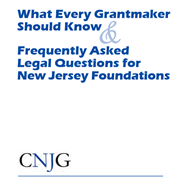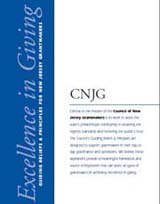Site Search
- resource provided by the Forum Network Knowledgebase.
Search Tip: Search with " " to find exact matches.

This guide was designed to help the state’s philanthropic community understand their ethical, legal, and fiduciary requirements and obligations.
Nonprofit Finance Fund's Annual Survey chronicles the challenges facing the nonprofit sector and calls out some of the targeted investments we can start to agree on as a society to salvage the investment we have collectively made in our social infrastructure. We believe that a coordinated intervention now will not only better prepare us for inevitable future economic crises; it can lead to a happier, healthier community for us all.
Grantmaking at the Crossroads is a workbook designed to provide foundations with a new grantmaking methodology that works at the intersection of place, population, and issue. It offers a pathway to greater inclusion of communities that are often excluded or marginalized by foundation funding and enables foundations to maintain their focus and priorities while expanding their reach and effectiveness.
The Grand Rapids Community Foundation and the Kalamazoo Community Foundation volunteered to be laboratories for Grantmaking at the Crossroads and have been critical informants for this workbook. Each of these foundations holds an unwavering commitment to ongoing learning; this publication would not have happened without their support and engagement and the financial support of the Arcus Foundation.
CNJG’s Finance and Investment Affinity Group exists to keep foundation executives informed as they manage the investment of their corpus. Growth of foundation assets and the active exchange of sound investment strategies is the focus of each program.
Join us for a breakfast presentation and Q&A where we will discuss J.P. Morgan’s views across traditional and alternative asset classes for the year ahead. Michael Pages and Chris Baldi will lead the discussion.
Michael Pages is a Senior Banker and Executive Director at J.P. Morgan. He works alongside a team of professionals who share responsibility for advising endowments, foundations and select family offices across the US on a variety of matters including asset allocation, portfolio construction, capital and liquidity strategies and execution. He has deep expertise in the Outsourced Chief Investment Officer (OCIO) model and is Team Lead.
Chris Baldi is a Vice President and Investment Specialist at J.P. Morgan Private Bank. He is responsible for advising ultra-high net worth families and senior executives on a variety of matters including asset allocation, portfolio construction, capital and liquidity strategies and execution.
Cost: Free for CNJG Members; $75 for Non Member Grantmakers (includes full breakfast)
Thank you to JP Morgan for hosting and providing breakfast for this program.
From the Commonfund, these white papers on investment policy statements, spending policy, board governance and risk tolerance, together with their most recent studies of investments at private and community foundations, operating charities and nonprofit healthcare organizations are made available though CNJG's Investment Forum for Foundations and Endowments.
A key objective of the Scaling What Works initiative has been to translate insight and learning from grantmaker intermediaries involved with the Social Innovation Fund and share them with the broader philanthropic community. The fifth guide in the Lessons Learned series presents the benefits and challenges of partnerships between local and national funders, and highlights key considerations for both kinds of funders to foster success in their collaboration.
Capacity building enables nonprofit leaders and organizations to develop the skills and resources they need to improve their work. Since each situation is unique and circumstances are always changing, effective capacity-building support is tailored to best suit the needs of grantees. This publication offers practical guidance and considerations to help grantmakers design an impactful approach.

This includes insights and tips related to board governance, legal compliance, grantee communications, fiscal responsibility, public disclosure, and many other key areas of foundation governance and operations. It is intended to serve as a practical resource to assist foundations in their grantmaking.
CNJG's 2018 Annual Meeting & Holiday Luncheon pre-meeting workshop with Michelle Greanias from PEAK Grantmaking focused on how foundation CEO’s, program officers, staff, and trustees could engage internally to put values-based grantmaking into practice.
Walk the Talk Video
In 2001, the Schumann Fund for New Jersey and 10 private and corporate foundations agreed to collaborate on the multi-year Newark Lighthouse Initiative. The Initiative, led by two state nonprofit partners, the Association for Children of New Jersey and New Jersey Community Capital, had program and policy goals: to help three Newark-based early childhood programs move from good to exemplary, and to identify policy changes that would be necessary to enable other early-childhood programs to engage in similar efforts.
Funders over the initiative’s six-year life included the Geraldine R. Dodge Foundation, Schumann Fund for New Jersey, Prudential Foundation, Lucent Technologies Foundation, Bank of America, Grable Foundation, Sagner Family Fund, Victoria Foundation, Toys “R” Us Children’s Fund, Healthcare Foundation of New Jersey, BEA Foundation, United Way of Essex and West Hudson, MCJ Foundation, and Rosie’s For All Kids Foundation. Many funders agreed to make multi-year grants or to consider proposals for renewal of support over the life of the project.
The money was used first to support a needs assessment for each center, and then to help the centers attract and retain the most qualified teachers, implement the best teaching methods, and obtain or renovate to improve facilities. A portion of the funds was set aside for an independent evaluation of the initiative. The three centers chosen – Friendly Fuld Neighborhood Child Care, Ironbound Children’s Center, and Vailsburg Child Development Center – already had strong programs and recognized leadership. The funders believed that the extra support would enable them to improve the quality of their programs, serve as exemplars for other programs in the city, and provide teachers and parents tangible evidence of what quality looks like.
The Schumann Fund participated in the collaborative for a number of reasons. First, we understood the value of high-quality early-childhood education to children’s later success in school and in the workforce. We knew that many of the community-based programs in Newark had been operating for years with insufficient resources. We viewed the Abbott decision, which requires that the state’s 31 poorest school districts make “high-quality, well-planned preschool” available to every three-and four-year-old in those districts, as an opportunity to expand access to preschool and improve it significantly. We recognized that our investment in quality improvement could be sustained by the operating funds that the state and districts were providing to the preschool programs.
Second, each collaborating funder brought different strengths: knowledge of early-childhood policy and evaluation, expertise in community economic development, and long-term commitment to community service organizations in Newark. Third, we believed that by working together, we could more effectively use our finite resources. We could make it possible for grantees to focus on quality improvement rather than raising monies from separate funders. Participating grantmakers helped to develop the project’s framework and encouraged their colleagues to consider supporting it. Finally, we believed that by modeling collaboration among ourselves, we could encourage greater collaboration among our grantees.
There were challenges, of course. Each grantmaker had different guidelines, reporting requirements, and timetables and processes for reviewing proposals. Some were able to make multi-year grants; others were not. Several changed their guidelines or operating approach during the course of the project and were not able to continue funding it for the entire six years. During its initial phase, some elements of the original proposal changed, including the evaluation process and timeline. It took longer for the project to get off the ground than we originally anticipated. But ultimately, the trust that was established between all of the involved parties enabled us to approve the changes in the operations and timeline.
The Lighthouse project achieved its original goals of supporting quality improvements in all of the participating programs. The Association for Children of New Jersey and New Jersey Community Capital provided excellent technical assistance and planning support and identified obstacles to quality improvement that needed to be addressed through policy advocacy. In addition, the directors of two of the three programs have become effective leaders in Newark’s early-childhood community, and have presented their experiences with this project to national audiences.
This effort required us to commit time and expertise, in addition to money. It takes more effort to collaborate than it does to work in our conventional way, but it is worth it. We came away with a new appreciation for the work of our grantees; an understanding of the need for flexibility amid changing conditions on the ground; and the satisfaction – backed up by a dynamic evaluation – that our efforts contributed to tangible improvements in life-opportunities for the children and families that the centers serve.
Would we do it again? We are. This year, several New Jersey funders joined with six nonprofits, including three community organizing groups, to respond to a national request for proposal for support of education organizing. We were awarded the grant, the only statewide effort of the four that were awarded. We anticipate that the effort will engage parents and community members in local and statewide efforts to improve schools. And, we have brought national attention and national money to our work.
Foundations Facilitate Diversity, Equity, and Inclusion: Partnering with Community and Nonprofits, a new report by the OMG Center for Collaborative Learning, confirms that foundations can, in fact, facilitate diversity, equity, and inclusion (DEI) through their grantmaking processes and their partnerships with nonprofits—and identifies eight specific practices for foundations to emulate.
The report takes a deep dive into the work of nine foundations that represent a diverse cross-section of types and sizes, and offers useful lessons about how foundations can better partner with nonprofits to be more effective in their work.
How the government can partner with impact investors to unleash new capital, talent and energy for maximum impact.
This paper explores community democracy as a cultural choice and a potential organizing system for philanthropy using stories that demonstrate its principles and practices, primarily growing from the experience of northern California communities. This experience offers a framework of principles and a beginning set of conclusions about how philanthropy can develop productive partnerships from the perspective of a place-based, community democracy.
The Ford Institute for Community Building, a program of The Ford Family Foundation, works to help community leaders learn how to implement local solutions based on principles of effective community building. This paper describes the development and work of the The Ford Institute for Community Building.
Directors & Officers liability insurance provides financial protection for a foundation and its directors, officers, employees, and volunteers in the event of a lawsuit. CNJG offers its members the D&O liability insurance program provided through Aon Association Services, underwritten by The Hartford and endorsed by the United Philanthropy Forum. A discount is available to foundations with current membership with CNJG.
Fiduciary Liability and other coverage is also available to members at a discounted rate. Coverage is available in all states. Brokers can access the Forum’s D&O program through Aon Association Services.
Learn more using the documents below, on the Aon website or by contacting Jason Tharpe, program administrator at Aon Affinity, at 202-429-8561. To obtain the discount, foundations should let Aon know they are a member of CNJG, a member of the United Philanthropy Forum.
